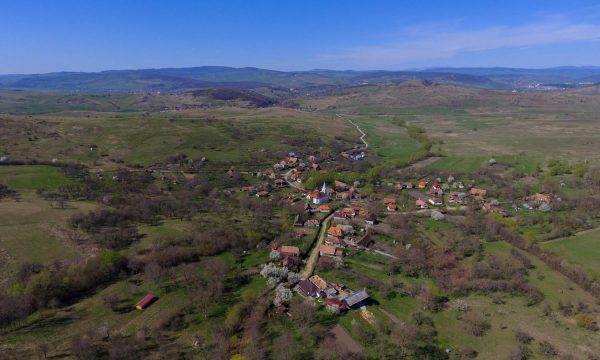The hilltop settlement lies 13 km south of Odorheiu Secuiesc (Hu: Székelyudvarhely), and belongs to the commune of Ulieș (Hu: Kanyád). The name of the village is first mentioned in 1448, in an official document issued by János Hunyadi, next to the name of juror János Weres ”de Zenthlászló”. In 1567 it appears in the Papal Regestrum with 8 families registered in the village. Scholar believe its name makes reference to the existence of a medieval church, dating to the Árpád period.

This theory is corroborated by Balázs Orbán, who wrote: „From the hill of Bágyi, a mountain chain winds towards the west, towards Dálya. The highest peak set above Ábranfalva is called Szabarcs. Legend has it that King Saint Ladislaus had his fortress here. Albeit I carefully searched this mountain, I did not find any remains of this castle or any fortified building. In the bottom of this mountain, facing the village Ége, a meadow is called “the land of prince” by locals. Traditionally, the arable lands in castle custody have long been here, and alas the village named Saint Ladislaus situated nearby is also an indicator of this region having hosted Saint Ladislaus”.
We may assume that the village also built a church dedicated to him. Balázs Orbán records the ruins of a chapel and belfry, found east of Obrănești (Hu: Ábránfalva), on Belfry Hill. According to historical sources in the beginning of the 14th century the church had a functioning monastery. During a wind storm in the 16th century it was destroyed, and the villagers moved the church east from the settlement. This old structure was unfortunately demolished in 1912 by the authorities. Its painted coffered ceiling was rescued and is currently in the custody of the Hungarian National Museum. This church was replaced by the new Reformed parish built in 1929.
Related to other settlement history elements, from an account written in 1735 we know this village also had a school, and in 1835 two teachers taught the young children enrolled. According to population evidence records, in 1614 the village had 21 families, in 1786 records show 121 people, and in 1910 207 people. After World War II this number started decreasing until the present.
